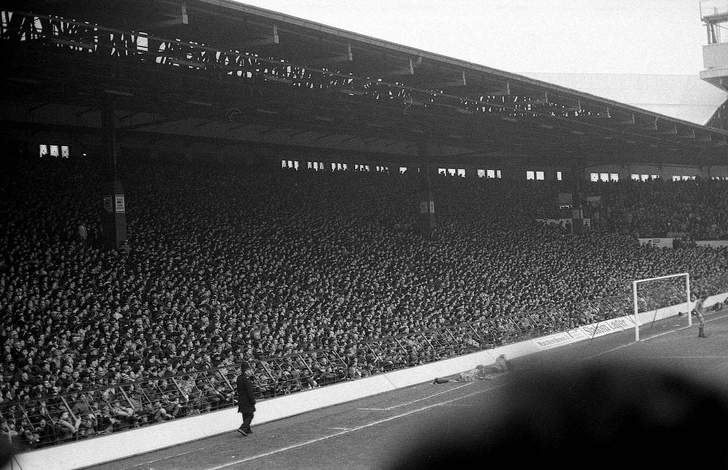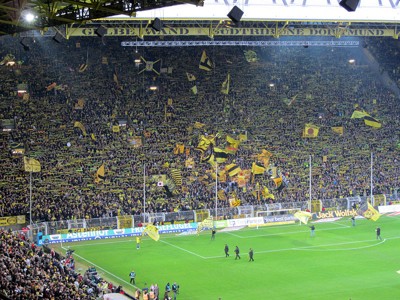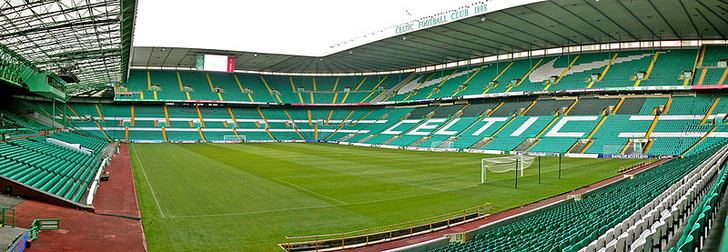 It goes without saying that what appeals to people about football is the play. People support teams and teams are made up of players, with the reasons why certain people begin supporting sides too numerous to mention.
It goes without saying that what appeals to people about football is the play. People support teams and teams are made up of players, with the reasons why certain people begin supporting sides too numerous to mention.
It’s often the players that will attract them in the first place, then they’ll fall in love with the club and remain supporting them for the rest of their lives.
Part of that support, though, usually involves heading to the football ground that the team calls home and supporting them in person. So it is that grounds begin to take on a personality of their own, with certain stands becoming known in their own right.
On this page we’ll explore those stands that have become famous of the years of their existence.
The Stands
Obviously there can be countless reasons why a stand might become famous, ranging from something that happened on them to them being the biggest or for some other reason. We’ll look at the top six most famous stands in football here and explore why it is that they’re so well-known, if the origin of their fame has been ascertained.
The Kop – ANFIELD

Arguably the most famous stand in world football, the Kop is where the most passionate Liverpool supporters spend their time on a match day. When the Reds won their second league championship in 1906, a new stand was built behind one of the goals. With stands already existing along one side of the pitch and at the Anfield Road end of the stadium, this new one was given a personality of its own.
The Sports Editor of the Liverpool Echo and the Liverpool Daily Post, Ernest Edwards, called it the Spion Kop, naming it after a famous hill in South Africa where more than 300 men had died during the Boer War, including many local people. A new stand was soon built along the Kemlyn Road side of the ground and the stadium remained in much the same state for more than two decades, until the Kop was redesigned in 1928.
It was extended to welcome more than 30,000 spectators, all of whom were standing, and a roof was put on to protect them from the elements. It made it into the largest Kop in the country, with numerous grounds also opening stands that were named after the Spion Kop. Such was the size of the Kop that it alone was able to host more supporters than some football grounds had the capacity to welcome.
The Kop at Anfield became so well known that it was claimed it could ‘suck the ball into the back of the net’, particularly on European nights. When the stadium announcer used to play the top ten in the charts before kick-off, the Kop would sing along with the song at number one. When that song was You’ll Never Walk Alone as sung by Gerry & The Pacemakers in the 1960s, it meant they sang it for four weeks and it became the club anthem.
In the wake of the Hillsborough Disaster, in which 96 Liverpool supporters died because of police negligence, the Taylor Report recommended that stadiums in the country should become all-seater. The Kop’s final stand came against Norwich City on the 30th of April 1994, with about 16,000 supporters stood on the stand to witness Liverpool legends of the past parade in front of them to wish the old Spion Kop goodbye.
The Kop still exists as a stand and remains one of the most famous in football. A statue of Bill Shankly stands in front of it, with the old stand still capable of producing some epic support for Liverpool. One of the most notable in the modern era came in 2019 when the Reds defeated Barcelona 4-0 to reach the final of the Champions League. When Liverpool won the Premier League title in 2020, the trophy was presented to the players on the Kop.
Yellow Wall – WESTFALENSTADION

It’s something of a coincidence that two of the most famous stands in football house supporters that sing You’ll Never Walk Alone before the match, but that’s exactly what happens at both Anfield and Signal Iduna Park. The latter is the home of Borussia Dortmund, the German team that interrupted Bayern Munich’s period of dominance in the Bundesliga during the 2010s.
The ‘Yellow Wall’ is known as a crown jewell of German football.The ‘Yellow Wall’ is so named because Dortmund’s home kit is yellow and the supporters take to the South Stand of the Westfalenstadion with flags and scarves of the colour to roar on the home side. It is 328 foot long and 131 foot high and is capable of welcoming 24,454 spectators, making it the largest terrace for standing in all of Europe. It helped Dortmund remain unbeaten at home in the 2012-2013 campaign, such is its influence.
Even the fact that supporters have to sit in the Südtribüne when playing European matches because of UEFA’s rules doesn’t limit the stand’s influence on matches, for which it has a fierce reputation. Bastian Schweinsteiger was once asked whether he fears the players of Borussia Dortmund or the club’s manager more, to which he replied, “It is the Yellow Wall that scares me the most,” indicating the power of the stand.
It was a theory confirmed by the club’s one-time goalkeeper Roman Weidenfeller, who said, “If you are the enemy, it crushes you but if you have her at your back as a goalkeeper, it’s a fantastic feeling.” It welcomes fans from all walks of life who combine their efforts to intimidate the opposition and offer unwavering support to the home fans. It is the ‘heart’ of BVB, according to former player Norbert Dickel.
The Westfalenstadion was built in advance of Germany hosting the 1974 FIFA World Cup, undergoing numerous expansions since then. The South Stand was able to host 12,000 people prior to it being enlarged after Dortmund’s success in the Champions League in 1997. The stand boasts an inclined angle of 37 degrees, which is part of what makes it so iconic and why it feels so intimidating for opposition players.
The South Stand – TOTTENHAM HOTSPUR STADIUM

The Kop and the Yellow Wall are as famous for their history as they are for what they look like, but the same can’t be said of the South Stand at the Tottenham Hotspur Stadium. It only opened in 2019, but it immediately made its way on to our list on account of the fact that it is the largest single-tier stand in English football. Boasting a 34 degree angle, it has room for 17,500 Spurs fans to take their seat and watch their team.
Given the entire stadium cost £1 billion to build, it’s only right that the home of the most vociferous Tottenham supporters has something special about it. The ground itself was designed like concert hall, meaning that acoustics were well-considered in order to offer a strong atmosphere. The stands are located close to the pitch in order to increase their ability to create a ‘wall of sound’, with design allowing it to reverberate around the stadium.
The ground’s bowl design means that it doesn’t necessary appear as if there are distinct stands at first glance. The South Stand is definitely stand out, however, with the home supporters taking up all the seats after accessing it from the south atrium. Its design has been influenced by that of the Yellow Wall at the Westfalenstadion, with the aim being to make it into the ‘heartbeat’ of the stadium that can create a great match day atmosphere.
The reality is that the story of Tottenham’s South Stand is yet to be written. Stands earn their place in the record books when they witness success, which is why both the Kop and the Yellow Wall are so well-loved. For Spurs fans to truly claim that the South Stand deserves to be spoken of alongside other famous stand in football they’ll need to roar the club on to league or cup success in a meaningful manner at some point in the future.
Gallowgate End – ST JAMES’ PARK

If Tottenham fans want proof that success isn’t a prerequisite of a stand become well-known in its own right then they need look no further than the Gallowgate End at St James’ Park in Newcastle. The reality is that Newcastle United’s success has been limited in the modern era, with the club yo-yoing between the Premier League and the Championship most seasons. Even so, the vocal nature of the club’s supporters ensure the Gallowgate End is respected in football.
St James’ Park opened for the first time in 1892, with the first stand being built at the Gallowgate End of the stadium. It was only small initially, being rebuilt in 1899 along with the rest of the stands, ensuring an initial capacity of 30,000. The capacity doubled six years later when more stands were built, but the Gallowgate End remained the centre point of the stadium, earning its name because it was the end where the city’s gallows were located.
Whilst certain changes were made to St James’ Park in the decades that followed, the first major alterations of the Gallowgate End took place in 1993. It was completely rebuilt, with all four corners of the stadium filled in too. It took the capacity to 36,610, with the Gallowgate End still being the focal point for Newcastle supporters. More seats were added to the stand during the construction that took place in the late 1990s.
The Gallowgate End was redeveloped again in 2005, with a bar being added and the upper tier of the stand being named ‘Shearer’s’ after the player of the same name. The builders discovered the original steps to the stand that had been covered up when the stadium was initially renovated, so these were removed to make room for Shearer’s Bar and the expansion of the club shop. A club museum was also added to the stand.
A ‘singing section’ was created in the corner between the Gallowgate End and the East Stand in what is unofficially known as the ‘Strawberry Corner’. This is because of its proximity to the Strawberry Pub. Whilst Newcastle’s on field success doesn’t match the vociferous nature of the supporters, it is still noteworthy that the stand is well-known because of the sound of tens of thousands of Geordies cheering on their team.
Lisbon Lions Stand – CELTIC PARK

If there’s one group of supporters in the world that can give Newcastle fans a run for their money when it comes to the passion of supporting their team then it’s Celtic fans. Weirdly, Celtic are also the third club on our list to run on to the pitch to the sound of You’ll Never Walk Alone, which is a strange coincidence indeed. That being said, it is a song that inspires passion and desire, so perhaps it’s not all that strange that the stands that sing it earn recognition.
Celtic Park, also known as Parkhead and even referred to as ‘Paradise’ by Celtic supporters, opened its doors in 1892, five years after Celtic had been formed. The stadium itself was impressive from the first moment it opened, with vast terraces welcoming supporters to such an extent that a record attendance of 83,500 was set in 1938. It’s not just Celtic fans that have enjoyed it either, with Scottish international matches having been played there.
It’s not only the fervent nature of Celtic’s supporters that has resulted in the Lisbon Lions Stand being added to our list of well-known stands. The ground was redeveloped during the 1990s, which resulted in the demolition of the terracing of the East Stand in 1994. When it re-opened it had capacity for 13,006 supporters, but it was the changes that took place in 2016 when safe standing was added to the Lisbon Lions Stand.
It had been given that moniker in 2000 in honour of the team that won the European Cup. The safe standing section added even more noise to an already impressive section of the ground, with 2,600 supporters accommodated thanks to the new rail seating. Given that supporters were standing anyway, this at least allowed them to do so in a safer manner. It is part of what makes the stand unique and a visual wonder on a match day.
